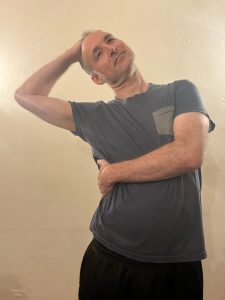This series consists of provocations to stimulate your body’s deep instinct to learn.
Written instructions are provided to invite you to be the author of your own process.
The practices can be explored briefly as a way to simply create a new pattern in the flow of your day or at greater length to allow for deeper investigations of your patterns and potentials.
Walk slowly in a circle. Choose a size for your circle such that you can walk its entire circumference in about a dozen paces with smaller-than-average steps.
Which foot is on the inside of the circle? Which foot is on the outside of the circle?
Notice how walking the circle places different demands on each of your two legs.
After traversing the circle several times, stand still with your eyes closed.
Listen to the sensations you feel from the top of your head down to the heel of your inside foot. Compare those sensations to what you feel on the other side.
Now walk the circle in the other direction, so that the former outside leg is now the inside leg and vice-versa. Notice if you find it simpler to walk in one direction.
Notice again how the circle places different demands on each leg and ask yourself how this might explain why you prefer walking in one direction over the other.
Take breaks or change directions whenever you wish, but keep going. Aim to discover how to walk the circles more comfortably. Paying attention to maintaining an easy, flowing breath will help you do this. Relax your jaw.
Notice sensations in your ankles, knees, hip joints, ribs, back, shoulders, neck, eyes.
Simply walking the circle without variation as a meditation will lead to insights, but you can also make more specific experiments.
For example:
- Walk as if you are walking on a circle painted on the ground
- Walk as if you are orbiting a single point at the center of the circle
- Imagine that point as being on the floor, on the ceiling, or in midair
- Orient yourself to points outside the circle instead of the center
Notice which among these ways of navigating the circle feels the simplest to you.
Also try out each of these options with the following postural variation:
Reach one hand over the top of your head to hold above your ear on the opposite side (your wrist will rest on top of your head). Let the weight of your elbow invite your head to tilt down on that side. With your other hand, reach across your chest to gently pull your middle ribs inward on the side where the head hangs.
Try to sense that your spine is now shaped like the letter ‘C’. Feel how your spine is shorter on the side where your head hangs down and longer on the other side.

Like this, walk the circle. Go slowly and take small steps to help with your balance.
After a while, switch your arms and walk the circle again. Later you can try each variation while walking the circle in the other direction.
Explore as long as you wish.
Finish by standing again, eyes closed, listening to your sensations.
Discussion:
When you walk in a circle, your inside leg takes smaller steps than your outside leg. This has at least two important consequences.
First, your walking pattern is necessarily asymmetrical. The distinct demands on each leg create differences in coordination and sensation that can be felt from head to toe.
The “postural variation” suggested here highlights that asymmetry by exaggerating the difference it makes to your spine. You’ll likely feel that tilting your head to the inside of the circle feels much simpler than tilting it out.
These asymmetries will highlight biases that may already be present in your habitual walking pattern due to old injuries or a host of other possible factors.
The leg you prefer to have on the inside is of particular interest. That hip joint is the axis you keep turning around. When you step on the outside foot and swing the inside leg, what happens in the outside hip joint is quite different.
Second, the uneven gait demanded by your circular path also requires a special use of your attention to calibrate your steps and stay on track. Your peripheral vision becomes an important tool for orientation and ongoing course correction.
When you walk the circle with a ‘C’- shaped spine, you may find that it is easier to orient to the ground when your head is tilted one way and easier to orient to the ceiling when your head is tilted the other way.
What the postural variation helps you recognize is how you use your spine to help steer yourself around the edge of the circle. It’s similar to the way you would lean into a curve if you were riding a bike.
There are more variations you could add to this inquiry if you like challenge.
You could walk backwards. You could cross one foot over the other with each step. You could traverse the circle with your gaze always in the same direction, like a dancer tracing a circle on a stage, always facing the audience.
You could combine all of these things in various ways – and close one eye!
You could keep building, endlessly, with your imagination.
[More like this can be found at Seth’s substack, found here.]
Feature Photo by gryffyn m on Unsplash.

